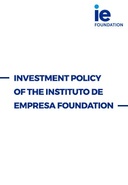- Home
- About Ie Foundation
- Investment Policy
Investment policy
The Foundation has a transparent Investment Policy which fundamental elements comprise the necessary criteria to offer a proper balance of profitability, security and liquidity of the investments made using the Foundation’s liquid resources.
In this context, the Investment Policy is an instrument that seeks to frame the definition of the Foundation’s investment strategy, within certain risk parameters, as well as comply with the limitations and best practices existing in this area for Foundations and non-profit entities.
I. INVESTMENT OBJECTIVE
To increase wealth and, essentially, preserve the capital invested.
II. SELECTION OF INVESTMENTS AND INVESTMENT MANAGERS
Investments are made through wealth managers or investment banks, in accordance with the following criteria and requirements:
• Diversification of managers in order to generate competition and comparability
• Best reputation and track record of success
• No minimum time commitment
• Lowest rates and management fees
• Dynamism in terms of adjusting the financial portfolio to market circumstances
• Experience in foundations and endowments
An investment portfolio has been designed with the managers, which is revised regularly, assessing, as a general rule, the increase or decrease in exposure of each kind of asset according to the expected return on the investment and its contribution to relative risk.
III. ADMINISTRATION OF THE INVESTMENT PORTFOLIO AND ITS RISKS
All aspects of the risks associated with the investments made using the Foundation’s resources are identified in this Policy.
Management of liquidity risk: The aim is to ensure that the investments have sufficient liquid instruments to satisfy liquidity needs at all times. The definition of “Liquid Instruments, considering the established market liquidity criteria, includes those attributed to the liquidity of the instrument itself and also the concentrations maintained in the financial portfolio. Accordingly, it is important to take into account not only the low costs of the transaction but also the expected time until the position maintained in each investment period is divested, which is mostly D+2.
Management of Market risk: Through the measurement of the different relevant market risk indicators (Beta, Volatility, VAR), the compliance with error tracking limits established in the Foundation’s investment policy is measured and monitored.
